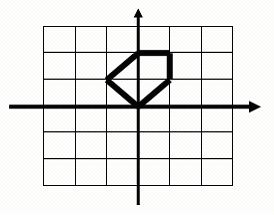POJ1065 Area
| Time Limit: 1000MS | Memory Limit: 10000K | |
| Total Submissions: 18499 | Accepted: 5094 |
Description
You are going to compute the area of a special kind of polygon. One vertex of the polygon is the origin of the orthogonal coordinate system. From this vertex, you may go step by step to the following vertexes of the polygon until back to the initial vertex. For each step you may go North, West, South or East with step length of 1 unit, or go Northwest, Northeast, Southwest or Southeast with step length of square root of 2.
For example, this is a legal polygon to be computed and its area is 2.5:

For example, this is a legal polygon to be computed and its area is 2.5:

Input
The
first line of input is an integer t (1 <= t <= 20), the number of
the test polygons. Each of the following lines contains a string
composed of digits 1-9 describing how the polygon is formed by walking
from the origin. Here 8, 2, 6 and 4 represent North, South, East and
West, while 9, 7, 3 and 1 denote Northeast, Northwest, Southeast and
Southwest respectively. Number 5 only appears at the end of the sequence
indicating the stop of walking. You may assume that the input polygon
is valid which means that the endpoint is always the start point and the
sides of the polygon are not cross to each other.Each line may contain
up to 1000000 digits.
Output
For each polygon, print its area on a single line.
Sample Input
4
5
825
6725
6244865
Sample Output
0
0
0.5
2
Source
最终会回到原点,所以只需要模拟每一步行走,用叉积计算当前点、上一个点、原点构成的三角形面积,累计求和即可。
注意:1、需要long long
2、单串长度可能小于3,需要特判输出0(加上这个就对了,诡异。大概是会出现步数不够,走不回原点的情况?)
1 #include<iostream> 2 #include<cstdio> 3 #include<cstring> 4 #include<algorithm> 5 #include<cmath> 6 using namespace std; 7 int mx[10]={0,1,1,1,0,0,0,-1,-1,-1}, 8 my[10]={0,-1,0,1,-1,0,1,-1,0,1}; 9 long long s; 10 int x,y; 11 long long area(int x1,int y1,int x2,int y2){//叉积求面积 12 return x1*y2-x2*y1; 13 14 } 15 int main(){ 16 int T; 17 scanf("%d\n",&T); 18 while(T--){ 19 char str[1000010]; 20 scanf("%s",str); 21 s=0; 22 x=0;y=0; 23 int len=strlen(str); 24 // 25 if(len<3){ 26 printf("0\n"); 27 continue; 28 } 29 // 30 for(int i=0;i<len;i++){ 31 int num=str[i]-'0'; 32 int nowx=x+mx[num]; 33 int nowy=y+my[num]; 34 s+=area(x,y,nowx,nowy); 35 x=nowx; 36 y=nowy; 37 } 38 if(s<0)s=-s; 39 if(s&1){ 40 printf("%lld.5\n",s/2); 41 } 42 else printf("%lld\n",s/2); 43 } 44 return 0; 45 }
本文为博主原创文章,转载请注明出处。

